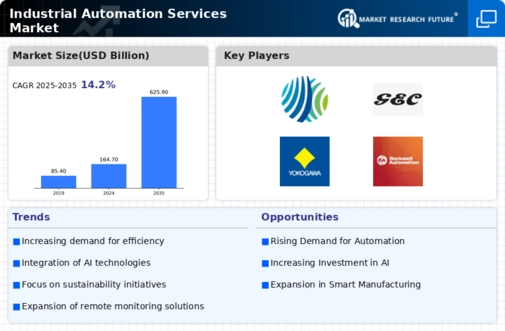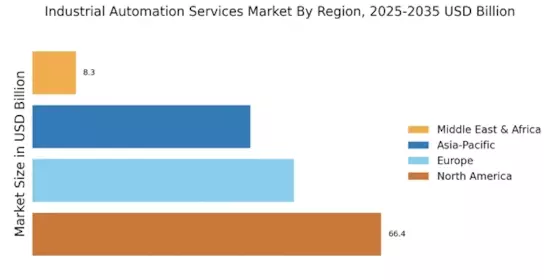Focus on Sustainability
Sustainability has emerged as a critical driver within the Industrial Automation Services Market. Companies are increasingly prioritizing eco-friendly practices and energy-efficient solutions to meet regulatory requirements and consumer expectations. The adoption of automation technologies can lead to significant reductions in energy consumption and waste generation. For example, automated systems can optimize resource usage, resulting in lower carbon footprints. As industries face mounting pressure to adopt sustainable practices, the demand for automation services that support these initiatives is expected to rise. This focus on sustainability not only aligns with corporate social responsibility goals but also enhances the overall competitiveness of businesses in the Industrial Automation Services Market.
Technological Advancements
Technological advancements play a pivotal role in shaping the Industrial Automation Services Market. Innovations in robotics, artificial intelligence, and the Internet of Things (IoT) are transforming traditional manufacturing processes. For instance, the implementation of IoT devices allows for real-time monitoring and data analysis, leading to improved decision-making and operational efficiency. The market for industrial automation is projected to reach USD 300 billion by 2026, driven by these technological innovations. As companies seek to leverage these advancements, the demand for automation services is likely to increase, fostering growth within the Industrial Automation Services Market. This continuous evolution of technology not only enhances productivity but also enables businesses to adapt to changing market demands.
Rising Demand for Efficiency
The Industrial Automation Services Market is experiencing a notable surge in demand for enhanced operational efficiency. Companies are increasingly adopting automation solutions to streamline processes, reduce operational costs, and improve productivity. According to recent data, organizations that implement automation can achieve efficiency gains of up to 30%. This trend is driven by the need to remain competitive in a rapidly evolving market landscape. As industries strive to optimize their operations, the reliance on automation services is expected to grow, thereby propelling the Industrial Automation Services Market forward. Furthermore, the integration of advanced technologies such as robotics and machine learning is likely to further enhance efficiency, making automation an indispensable component of modern industrial operations.
Labor Shortages and Skills Gap
The Industrial Automation Services Market is significantly influenced by labor shortages and the skills gap prevalent in various sectors. As industries face challenges in finding skilled labor, the adoption of automation solutions becomes increasingly attractive. Automation can mitigate the impact of labor shortages by enhancing productivity and allowing companies to maintain operations with fewer employees. Reports indicate that nearly 70% of manufacturers are struggling to find qualified workers, which is likely to drive the demand for automation services. Consequently, businesses are investing in automation technologies to bridge the skills gap and ensure operational continuity. This trend is expected to bolster the growth of the Industrial Automation Services Market as companies seek to automate processes to counteract workforce challenges.
Increased Investment in Smart Manufacturing
Investment in smart manufacturing is a key driver of the Industrial Automation Services Market. As industries transition towards smart factories, characterized by interconnected systems and data-driven decision-making, the demand for automation services is expected to rise. The market for smart manufacturing is projected to grow significantly, with investments reaching USD 250 billion by 2025. This shift towards smart manufacturing is fueled by the desire for enhanced flexibility, efficiency, and responsiveness to market changes. Companies are increasingly recognizing the value of integrating automation technologies to achieve these objectives. As a result, the Industrial Automation Services Market is likely to benefit from this trend, as businesses seek to implement advanced automation solutions to thrive in an increasingly competitive environment.


















Leave a Comment